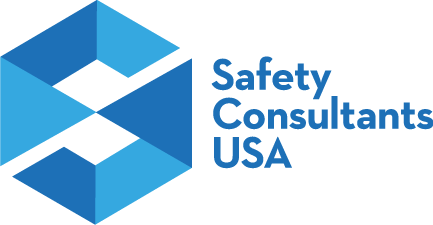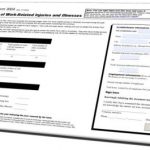OSHA 300a Logs Deadline for 2025
February 1st is the deadline to post your organization’s OSHA 300a logs. And March 2nd is the deadline to submit electronic records to OSHA. While the form itself is only a few pages, the associated OSHA Regulation governing the completion of the logs is well over twenty-five pages with multiple letters of interpretation to guide us in this endeavor.
Most injuries are straightforward and easily recorded, but we still often find mistakes on logs. And mistakes in your logs can disqualify you from bidding on work, which frequently happens.
General contractors typically use DART rates and incident rates to determine who is eligible to bid on work so an accurate log is more important than ever. Additionally, higher rates of injury may increase your organization’s likelihood of an OSHA inspection.
- Not updating OSHA 301 and 300 forms within seven calendar days of a recordable injury.
Solution: Following an injury, you must document what occurred on form 301 (or your company’s equivalent) and update for 300 with whatever information you have currently, even if the employee has not yet returned to work. You must be able to produce your log to OSHA upon request from OSHA within 4 hours. Don’t wait until January to complete your forms. - Not separating business locations and employee groups by establishment.
Solution: Projects and work locations that last one year or longer are considered separate establishments and should be separated. This is extremely important for companies where one division has a higher incident rate than another because it can prevent one division from bidding work that is vital to their cash flow.If your organization operates multiple facilities at different addresses those locations should each be treated as an establishment and keep their own log if that location has more than 10 employees. For companies that have multiple buildings at the same address where each building is performing operations that fall under a separate NAICS or SIC code then each of those buildings is considered its own establishment for purposes of creating OSHA logs and should maintain a separate log if each building has more than 10 employees working in it. - Not updating 300 Forms when mistakes are discovered or corrections are needed.
Solution: Again, because you must be able to produce these logs quickly upon request, not making changes as they come up will most certainly result in a delay in record production. Correct these forms as the information becomes available and you will avoid a paperwork nightmare later. - Recording ALL injuries and illnesses on the 300 Form when not required per OSHA.
Solution: Not every injury and illness meets the criteria to make it recordable. Did you know first aid only injuries do not need to be reported on your 300 logs? Make sure every injury you record meets the recordable criteria.Not sure what to exclude? Here is how OSHA defines first aid:- Using a non-prescription medication at nonprescription strength (for medications available in both prescription and non-prescription form, a recommendation by a physician or other licensed healthcare professional to use a non-prescription medication at prescription strength is considered medical treatment for recordkeeping purposes).
- Administering tetanus immunizations (other immunizations, such as Hepatitis B vaccine or rabies vaccine, are considered medical treatment); Cleaning, flushing or soaking wounds on the surface of the skin
- Using wound coverings such as bandages, Band-Aids™, gauze pads, etc., or using butterfly bandages or Steri-Strips™ (other wound closing devices, such as sutures, staples, etc., are considered medical treatment).
- Using hot or cold therapy.
- Using any non-rigid means of support, such as elastic bandages, wraps, non-rigid back belts, etc. (devices with rigid stays or other systems designed to immobilize parts of the body are considered medical treatment for recordkeeping purposes).
- Using temporary immobilization devices while transporting an accident victim (e.g., splints, slings, neck collars, backboards, etc.).
- Drilling of a fingernail or toenail to relieve pressure or draining fluid from a blister.
- Using eye patches.
- Removing foreign bodies from the eye using only irrigation or a cotton swab.
- Removing splinters or foreign material from areas other than the eye by irrigation, tweezers, cotton swabs or other simple means.
- Using finger guards.
- Using massages (physical therapy or chiropractic treatment are considered medical treatment for recordkeeping purposes).
Drinking fluids for relief of heat stress.
- Not recording injuries by employees working from home or at business-related events when the injury is due to the work.
Solution: In a world where a large majority of office staff are now working from home, this is more prevalent than ever before. Be sure to record injuries to employees who are working from home as appropriate and for those attending work functions offsite. - The signature certifying the accuracy of the form is not a “company executive.”
Solution: OSHA expects a company officer or individual with an ownership stake to certify – not the Branch or Safety Manager. Be certain that the person signing the form has the authority to do so. - Not posting logs for the required period.
Solution: OSHA 300a logs are required to be posted annually from February 1st through April 30th. - Not submitting data electronically using the ITA system by March 2nd.
Solution: Certain high-hazard industries are required to submit their 300a (summary data) to OSHA using the Injury Tracking Application. Companies with more than 250 employees and companies with 20-249 employees in the industries listed in this table:
https://www.osha.gov/recordkeeping/naics-codes-electronic-submission are required to submit their summary data from the 300a using the ITA system. - Not submitting form 301 electronically.
Solution: Companies with more than 100 employees that work in certain high-hazard industries are now required to submit their form 301 (Injury and Illness Incident Report ) to OSHA electronically using the Injury Tracking Application (https://www.osha.gov/injuryreporting/ita) This is a new and separate requirement for businesses. You can determine if your business meets the criteria by searching Appendix B. (https://www.osha.gov/sites/default/files/appendix_b_to_subpart_e_of_part_1904.pdf) - Not using your company’s legal name when completing and submitting logs
Solution: Establishments are required to use their legal company name when making electronic submissions to OSHA from their injury and illness records. This means you should not file under a DBA. It’s also important to maintain consistency in the entity name that you use so that it does not appear that you did not submit your log when previously required.
And here are two frequently asked questions about OSHA 300 Logs.
Why is OSHA collecting all this additional data?
OSHA has stated that the collection of this electronic data will allow the agency to interact in a more meaningful way with the establishments that are self-reporting, including through the use of enforcement and outreach (read: inspections). OSHA plans to utilize the data to analyze which industries have the most injuries, processes that increase the likelihood of injury and hazards in the workplace that cause greater risk of injury to employees.
OSHA has also stated access to establishment-specific data will allow the public to make informed decisions. This includes employees, potential employees, employee representatives, customers, potential customers and the general public.
What about my employee’s personal data?
OSHA has stated that it is taking steps to protect the identities and personal information of injured workers. Employees should expect the following from OSHA when collecting data from their employer:
- OSHA will not collect worker names and addresses
- Birthdates will be converted to age and the birthdate itself will be discarded
- OSHA will remind employers not to submit information directly identifying workers, such as names, addresses, telephone numbers, etc.
- OSHA will not publish age, gender, date hired and information related to hospital treatment
- OSHA will use automated information technology to identify and remove information directly identifying workers.
If you have questions about how to complete your OSHA 300 logs, you can always reference the OSHA website here: https://www.osha.gov/recordkeeping/entryfaq.html.
And, as always, Safety Consultants USA is happy to clarify any questions you may have about how to properly record employee injuries.


